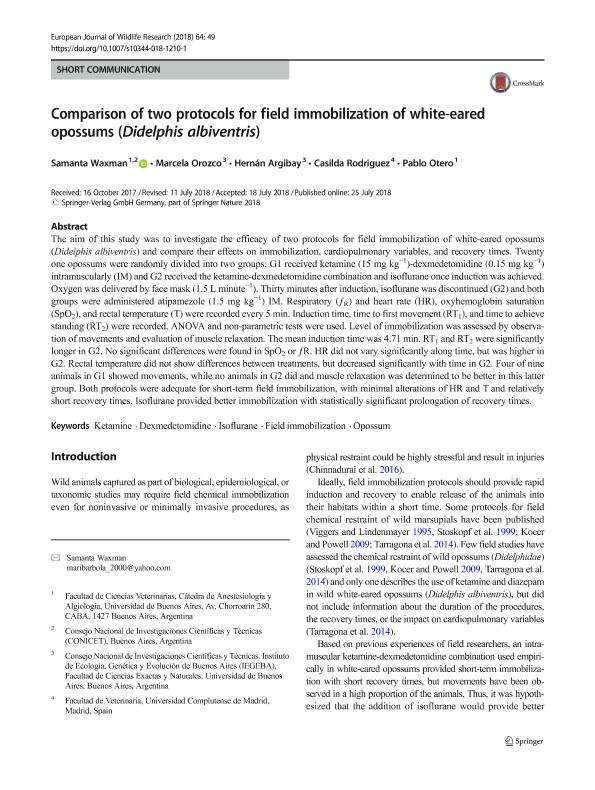Artículo
Comparison of two protocols for field immobilization of white-eared opossums (Didelphis albiventris)
Waxman Dova, Samanta ; Orozco, Maria Marcela
; Orozco, Maria Marcela ; Argibay, Hernán Darío
; Argibay, Hernán Darío ; Rodriguez, Casilda; Otero, Pablo Ezequiel
; Rodriguez, Casilda; Otero, Pablo Ezequiel
 ; Orozco, Maria Marcela
; Orozco, Maria Marcela ; Argibay, Hernán Darío
; Argibay, Hernán Darío ; Rodriguez, Casilda; Otero, Pablo Ezequiel
; Rodriguez, Casilda; Otero, Pablo Ezequiel
Fecha de publicación:
08/2018
Editorial:
Springer
Revista:
European Journal of Wildlife Research
ISSN:
1612-4642
Idioma:
Inglés
Tipo de recurso:
Artículo publicado
Clasificación temática:
Resumen
The aim of this study was to investigate the efficacy of two protocols for field immobilization of white-eared opossums (Didelphis albiventris) and compare their effects on immobilization, cardiopulmonary variables, and recovery times. Twenty one opossums were randomly divided into two groups; G1 received ketamine (15 mg kg−1)-dexmedetomidine (0.15 mg kg−1) intramuscularly (IM) and G2 received the ketamine-dexmedetomidine combination and isoflurane once induction was achieved. Oxygen was delivered by face mask (1.5 L minute−1). Thirty minutes after induction, isoflurane was discontinued (G2) and both groups were administered atipamezole (1.5 mg kg−1) IM. Respiratory (ƒR) and heart rate (HR), oxyhemoglobin saturation (SpO2), and rectal temperature (T) were recorded every 5 min. Induction time, time to first movement (RT1), and time to achieve standing (RT2) were recorded. ANOVA and non-parametric tests were used. Level of immobilization was assessed by observation of movements and evaluation of muscle relaxation. The mean induction time was 4.71 min. RT1 and RT2 were significantly longer in G2. No significant differences were found in SpO2 or ƒR. HR did not vary significantly along time, but was higher in G2. Rectal temperature did not show differences between treatments, but decreased significantly with time in G2. Four of nine animals in G1 showed movements, while no animals in G2 did and muscle relaxation was determined to be better in this latter group. Both protocols were adequate for short-term field immobilization, with minimal alterations of HR and T and relatively short recovery times. Isoflurane provided better immobilization with statistically significant prolongation of recovery times.
Palabras clave:
DEXMEDETOMIDINE
,
FIELD IMMOBILIZATION
,
ISOFLURANE
,
KETAMINE
,
OPOSSUM
Archivos asociados
Licencia
Identificadores
Colecciones
Articulos(IEGEBA)
Articulos de INSTITUTO DE ECOLOGIA, GENETICA Y EVOLUCION DE BS. AS
Articulos de INSTITUTO DE ECOLOGIA, GENETICA Y EVOLUCION DE BS. AS
Articulos(OCA PQUE. CENTENARIO)
Articulos de OFICINA DE COORDINACION ADMINISTRATIVA PQUE. CENTENARIO
Articulos de OFICINA DE COORDINACION ADMINISTRATIVA PQUE. CENTENARIO
Citación
Waxman Dova, Samanta; Orozco, Maria Marcela; Argibay, Hernán Darío; Rodriguez, Casilda; Otero, Pablo Ezequiel; Comparison of two protocols for field immobilization of white-eared opossums (Didelphis albiventris); Springer; European Journal of Wildlife Research; 64; 4; 8-2018; 1-4
Compartir
Altmétricas



